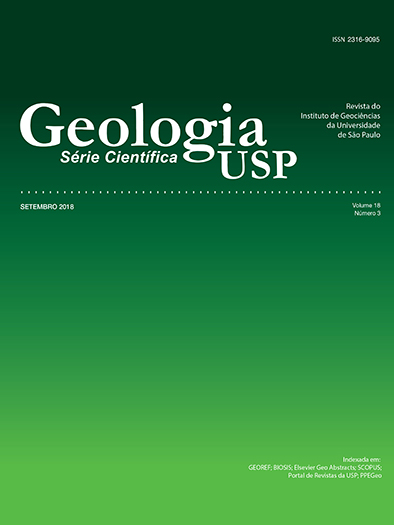Thermal aureole provoked by the intrusion of the Totoró pluton over micaschists of the Seridó Group, Ediacaran of the Borborema Province, NE Brazil
DOI:
https://doi.org/10.11606/issn.2316-9095.v18-125724Keywords:
Plutonism, Thermal aureole, Ediacaran, Borborema Province; NE BrazilAbstract
The Borborema Province, NE Brazil, is marked by significant Ediacaran plutonism. In this geological context, the Totoró pluton, Rio Grande do Norte, produces an extensive metamorphic aureole along the contact with micaschist of the Seridó Group. This contribution reports data from field work, petrography, mineral chemistry and rock petrophysics aiming to characterize this aureole. The Totoró pluton is an NNE-SSW elongate mafic to felsic body including diorite, gabbro-norite, granodiorite/tonalite (the main facies), biotite-bearing equigranular to porphyritic granite, and fine- to medium-grained granite. Geothermometric calculations based on mineral chemistry permitted estimating pressures of 1.6 – 2.7 kbar and temperature of 800 – 900ºC for the emplacement of the pluton. The thermal aureole can reach up to 2 km away from the contact and consists of: (i) migmatized schist immediately adjacent to the contact, often with leucosomes subconcordant with the S2 tectonic fabric of the host rocks; (ii) an intermediate zone with sillimanite (± cordierite + garnet + biotite); (iii) a zone with cordierite (± staurolite ± andalusite + garnet + biotite); (iv) an external zone of fine-grained micaschist. Petrophysical modelings reveal that the temperature next to the pluton reached 688 – 756ºC. Minerals of the metamorphic aureole define a low angle S2 schistosity (D2/M2 event in amphibolite to pyroxene hornfels facies), which are overprinted by open to tight folds, that evolve via strong transposition to generate mylonites in NE-SW to N-S directed shear zones, which represent the last ductile event (D3/M3). The results indicate that some regional batoliths (e.g., Acari, Totoró, Umarizal) were emplaced in a relatively shallow crust that provided locally very high geothermal gradient.
Downloads
Downloads
Published
Issue
Section
License
Authors who publish in this journal shall comply with the following terms:
- Authors keep their copyright and grant to Geologia USP: Série Científica the right of first publication, with the paper under the Creative Commons BY-NC-SA license (summary of the license: https://creativecommons.org/licenses/by-nc-sa/4.0 | full text of the license: https://creativecommons.org/licenses/by-nc-sa/4.0/legalcode) that allows the non-commercial sharing of the paper and granting the proper copyrights of the first publication in this journal.
- Authors are authorized to take additional contracts separately, for non-exclusive distribution of the version of the paper published in this journal (publish in institutional repository or as a book chapter), granting the proper copyrights of first publication in this journal.
- Authors are allowed and encouraged to publish and distribute their paper online (in institutional repositories or their personal page) at any point before or during the editorial process, since this can generate productive changes as well as increase the impact and citation of the published paper (See The effect of Open Access and downloads on citation impact).





